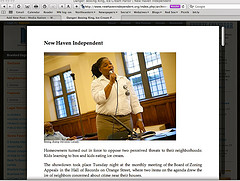 Back in February, we paid $20 for an 18-month subscription to the print edition of Time magazine. All right, it was a “professional” rate, available to us because I’m a journalism professor. But no one pays the full $4.95-per-issue cover price. If you sign up for a subscription online, for instance, you’ll be charged just $19.95 for six months.
Back in February, we paid $20 for an 18-month subscription to the print edition of Time magazine. All right, it was a “professional” rate, available to us because I’m a journalism professor. But no one pays the full $4.95-per-issue cover price. If you sign up for a subscription online, for instance, you’ll be charged just $19.95 for six months.
So count Time Warner executives among those who have been sucked into Steve Jobs’ famed “reality-distortion zone.” Because they are groping their way toward a paid-content strategy for Time that makes little or no sense. As explained by the Nieman Journalism Lab here and here, it includes these elements:
- The magazine is now available as an iPad app costing a flat $4.99 per issue — no discounts, thank you very much. The same folks who understand fully that you won’t pay some $250 a year for the print edition think you’ll gladly fork over the money so that you’ll have something to read on your new toy.
- The full content of the print edition has been pulled from Time.com, the magazine’s excellent website. There is still a lot of Web-only content available, much of it more, uh, timely and relevant than what appears in print. But when you try to access most articles from the print product, you get a summary and a plea to buy the magazine or the app.
- The paid app is available only for the iPad, even though it would not be difficult to rewrite it for computers and other devices. (There is a Kindle app for Time that costs a far more reasonable $2.99 per month. Then again, what would Time be without great photography?)
- The Web-only content is not included in the iPad app, which means that Time’s best customers will have to fire up Safari to see what they’re missing. And, of course, if there’s any Flash content on Time.com, they won’t be able to see it unless they switch to their computer. (There is some extra content included in the app.)
The folks at Time started with the right idea. Within the past year or so some pretty smart people have concluded that print and the Web should be used for different things, with the Web being used for breaking news, community and participation. Just as an experiment, it would be interesting to see whether Time could build a successful website without relying on content from the print edition.
But app fever is clouding Time’s judgment. The print edition arrives at Media Nation without fail every Saturday, and we didn’t even have to drop $500 on an iPad to get it. Slick as the app may be, it’s not as slick as glossy paper.
At the moment, Time is not offering a subscription to its app — it’s sold strictly on an issue-by-issue basis. When subscriptions do become available, Time ought to drop the price so that it’s the same as the print edition. Only then will we be able to see if there’s any demand.



